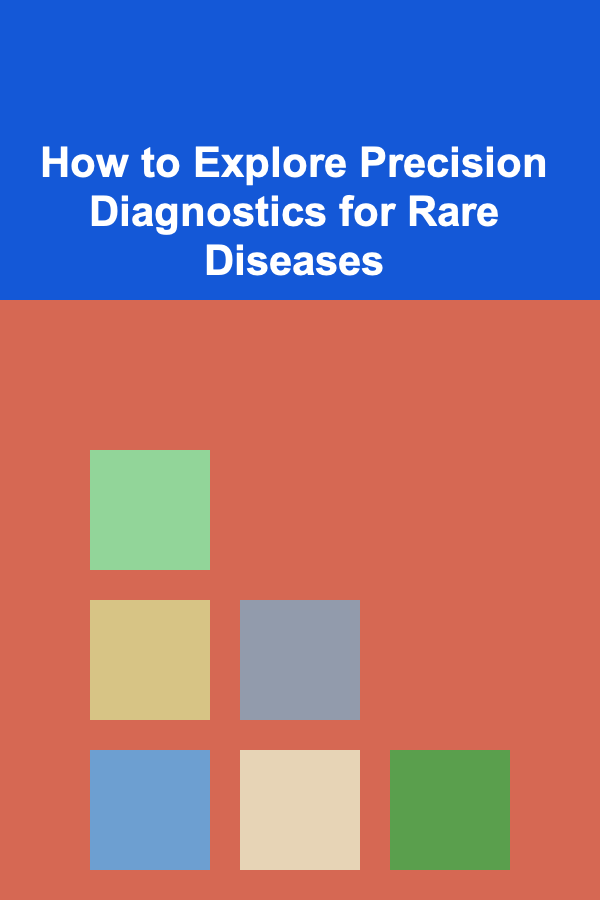
How to Explore Precision Diagnostics for Rare Diseases
ebook include PDF & Audio bundle (Micro Guide)
$12.99$6.99
Limited Time Offer! Order within the next:

Rare diseases are often overlooked in mainstream medical research due to their low prevalence. Despite their rarity, these diseases can have profound impacts on the individuals affected by them. According to the World Health Organization (WHO), there are over 7,000 known rare diseases, many of which are genetic in origin and can lead to chronic, debilitating conditions or even death. The lack of awareness, combined with the complexity of these diseases, makes them a significant challenge for diagnosis and treatment.
In recent years, the emergence of precision diagnostics has provided new hope for patients suffering from rare diseases. This approach, which tailors medical treatment to individual patients based on their genetic makeup, environmental factors, and lifestyle, has the potential to revolutionize how rare diseases are diagnosed and treated. However, the journey toward precision diagnostics for rare diseases is filled with challenges, from the need for advanced technologies to the scarcity of data.
This article explores the process of exploring precision diagnostics for rare diseases, its current status, challenges, advancements, and how this approach can pave the way for more effective treatments and better patient outcomes.
Understanding Rare Diseases
What Are Rare Diseases?
Rare diseases, also known as orphan diseases, are defined as conditions that affect a small percentage of the population. According to the National Institutes of Health (NIH), a rare disease is one that affects fewer than 200,000 people in the United States. Worldwide, it is estimated that around 350 million people suffer from rare diseases, yet they often struggle to receive accurate diagnoses and appropriate treatment.
Rare diseases are highly diverse in terms of their clinical presentation, ranging from congenital genetic disorders to acquired conditions. Many of these diseases are caused by mutations in specific genes, while others result from environmental factors or a combination of both. Some rare diseases are progressive and cause severe disabilities or life-threatening complications. However, the relatively low number of cases means that research and clinical trials are often underfunded, and medical professionals may lack experience in diagnosing these conditions.
Challenges in Diagnosing Rare Diseases
Diagnosing rare diseases can be particularly difficult due to several factors. One of the key challenges is the fact that many rare diseases have overlapping symptoms with more common conditions. For example, a rare disease that causes chronic fatigue may be mistaken for a common condition such as fibromyalgia. Additionally, some rare diseases have symptoms that may not appear until later in life, making them harder to detect in early stages.
Moreover, the diagnostic process is often complicated by the lack of a clear understanding of the disease's underlying mechanisms. While advancements in genomics and molecular biology have led to the identification of many disease-causing genes, many rare diseases remain poorly understood. As a result, patients may undergo a long and frustrating diagnostic journey, with multiple tests and consultations before receiving a definitive diagnosis.
What is Precision Diagnostics?
Precision diagnostics is a medical approach that uses individual patient data, such as genetic, environmental, and lifestyle factors, to identify diseases and tailor treatment strategies. Unlike the traditional "one-size-fits-all" approach to medicine, precision diagnostics focuses on the unique characteristics of each patient, aiming to provide more accurate diagnoses and personalized treatment options.
Key Components of Precision Diagnostics
- Genetic Testing: Advances in genomics have made it possible to sequence entire genomes quickly and cost-effectively. For patients with rare diseases, genetic testing can provide crucial insights into the underlying genetic mutations responsible for their condition. Whole genome sequencing (WGS) and whole exome sequencing (WES) are commonly used techniques to identify genetic variants associated with rare diseases.
- Biomarkers: Precision diagnostics also involves the use of biomarkers, which are measurable indicators of disease presence or progression. Biomarkers can be found in blood, urine, or tissue samples, and they can provide valuable information for diagnosing rare diseases and monitoring treatment responses.
- Clinical Data: Patient-specific clinical data, including medical history, symptoms, and family history, are essential for making an accurate diagnosis. By combining this information with genetic and biomarker data, clinicians can better understand the disease's progression and how it affects the individual patient.
- Artificial Intelligence (AI) and Machine Learning: AI and machine learning have the potential to revolutionize precision diagnostics by analyzing large datasets to uncover patterns and make predictions. These technologies can assist in identifying rare diseases, predicting outcomes, and even recommending personalized treatment plans.
The Role of Precision Diagnostics in Rare Diseases
Precision diagnostics offers several potential benefits for patients with rare diseases. By identifying the precise cause of a disease, clinicians can develop more accurate treatment plans, reduce the time to diagnosis, and improve patient outcomes.
1. Faster Diagnosis and Reduced Diagnostic Odyssey
One of the major advantages of precision diagnostics is the potential for faster and more accurate diagnosis. Traditional diagnostic methods for rare diseases often involve a lengthy process, with patients visiting multiple specialists and undergoing a battery of tests before receiving a definitive diagnosis. This "diagnostic odyssey" can take years, leaving patients and their families feeling frustrated and helpless.
With precision diagnostics, genetic testing and biomarker analysis can help identify rare diseases more quickly. By pinpointing the specific genetic mutation responsible for a patient's condition, clinicians can provide a diagnosis in a matter of weeks or months, rather than years. This not only reduces the emotional and psychological toll on patients and families but also enables early intervention, which is crucial for improving outcomes.
2. Personalized Treatment Plans
Rare diseases often have complex and unique molecular mechanisms, making it challenging to find effective treatments. However, precision diagnostics allows for the development of personalized treatment plans based on a patient's specific genetic and clinical profile. For example, if a genetic mutation is identified as the cause of a rare disease, targeted therapies or gene therapies can be considered.
Moreover, precision diagnostics can help identify the most effective drugs for an individual patient. For instance, pharmacogenomic testing can reveal how a patient's genetic makeup influences their response to medications. This can help avoid ineffective treatments and reduce the risk of adverse side effects, leading to better outcomes and quality of life for patients.
3. Improved Disease Understanding and Drug Development
The identification of genetic mutations and biomarkers associated with rare diseases is essential for improving our understanding of these conditions. By uncovering the molecular mechanisms underlying rare diseases, precision diagnostics contributes to the development of new therapeutic targets and drugs. This is particularly important for rare diseases, which often lack effective treatments.
In recent years, there has been a growing emphasis on orphan drug development, with regulatory agencies offering incentives such as tax breaks, market exclusivity, and fast-track approval for drugs targeting rare diseases. Precision diagnostics plays a crucial role in this process by identifying the specific genetic mutations or biomarkers that drugs can target.
Advancements in Precision Diagnostics for Rare Diseases
Several advancements in the field of precision diagnostics have significantly improved our ability to diagnose and treat rare diseases. These include innovations in genetic testing, biomarker discovery, AI and machine learning, and collaboration between researchers, clinicians, and patients.
1. Next-Generation Sequencing (NGS)
Next-generation sequencing (NGS) technologies have revolutionized genetic testing by making it faster, cheaper, and more accurate. NGS allows for the sequencing of entire genomes or exomes, enabling the identification of rare genetic mutations that may be responsible for a disease. This has been particularly beneficial for diagnosing rare genetic disorders that were previously difficult to identify using traditional sequencing methods.
WGS and WES are now routinely used to diagnose rare diseases, providing invaluable insights into the genetic underpinnings of these conditions. NGS has not only improved diagnostic accuracy but also reduced the cost and time required for testing, making it more accessible to patients worldwide.
2. Advancements in Biomarker Discovery
Biomarkers are critical for diagnosing rare diseases, monitoring disease progression, and assessing treatment responses. Recent advances in mass spectrometry, proteomics, and metabolomics have facilitated the discovery of novel biomarkers for a range of rare diseases. These biomarkers can be used to detect diseases earlier, guide treatment decisions, and monitor patient outcomes.
For example, researchers have identified specific biomarkers for diseases like Gaucher's disease and Huntington's disease, which can help clinicians make more accurate diagnoses and personalize treatment plans. Ongoing research in biomarker discovery continues to open new possibilities for precision diagnostics in rare diseases.
3. AI and Machine Learning
Artificial intelligence (AI) and machine learning are playing an increasingly important role in precision diagnostics for rare diseases. These technologies can analyze vast amounts of genetic, clinical, and environmental data to identify patterns that may be missed by human clinicians. AI algorithms can also predict disease progression, identify potential drug candidates, and assist in personalized treatment planning.
One example of AI in rare disease diagnostics is the use of deep learning algorithms to analyze genetic data and predict the likelihood of disease-causing mutations. Machine learning can also be applied to clinical data, helping clinicians make more accurate diagnoses based on symptoms, medical history, and genetic information.
4. Patient-Centered Approaches
The involvement of patients and their families is essential in the exploration of precision diagnostics for rare diseases. Patient registries, which collect data on individuals with specific rare diseases, are becoming an increasingly valuable resource for researchers and clinicians. These registries provide valuable information on disease progression, genetic variants, and treatment outcomes, which can help guide future research and improve diagnosis and treatment.
Patient advocacy groups are also playing a crucial role in raising awareness of rare diseases and advocating for more research funding. These groups are helping to connect patients with researchers, clinicians, and industry partners, facilitating the development of new diagnostics and treatments.
Challenges in Exploring Precision Diagnostics for Rare Diseases
Despite the promise of precision diagnostics for rare diseases, several challenges remain. These include the need for more comprehensive data, ethical concerns, accessibility issues, and the cost of new technologies.
1. Data Scarcity and Fragmentation
One of the biggest challenges in exploring precision diagnostics for rare diseases is the scarcity and fragmentation of data. Because rare diseases are so infrequent, there is often a lack of comprehensive data on the genetic and clinical characteristics of patients. This makes it difficult to identify reliable biomarkers, develop diagnostic tests, and conduct clinical trials.
To overcome this challenge, large-scale data-sharing initiatives are needed. Collaborations between academic institutions, research organizations, and patient advocacy groups can help collect and share data, creating a more comprehensive understanding of rare diseases.
2. Ethical and Privacy Concerns
The use of genetic data in precision diagnostics raises ethical and privacy concerns. For example, there may be concerns about the potential for genetic discrimination by employers or insurers, as well as issues related to the informed consent process and the sharing of genetic data. Researchers and clinicians must ensure that patient data is protected and that individuals understand the potential risks and benefits of genetic testing.
3. Cost and Accessibility
Precision diagnostics can be expensive, particularly for patients with rare diseases who may require multiple tests, consultations, and treatments. The high cost of next-generation sequencing, biomarker testing, and AI-based diagnostic tools can limit access to these technologies, particularly in low- and middle-income countries.
Efforts must be made to reduce the cost of precision diagnostics and ensure that these technologies are accessible to all patients, regardless of their socioeconomic status or geographic location.
Conclusion
The exploration of precision diagnostics for rare diseases has the potential to revolutionize the way we diagnose and treat these conditions. By tailoring medical care to the individual characteristics of each patient, precision diagnostics can provide more accurate diagnoses, personalized treatment plans, and improved patient outcomes.
While there are still challenges to overcome, including data scarcity, ethical concerns, and cost barriers, recent advancements in genetic testing, biomarker discovery, AI, and patient-centered approaches are making precision diagnostics increasingly accessible and effective.
In the future, precision diagnostics could pave the way for earlier detection, more effective treatments, and a better quality of life for individuals suffering from rare diseases. By continuing to invest in research, collaboration, and patient-centered care, we can unlock the full potential of precision diagnostics and provide hope for those affected by rare diseases.

Beginner Guide: The Essentials of Project Management
Read More
How to Install a Home Safe for Maximum Protection of Valuables
Read More
How to Maintain a Clean and Tidy Entryway
Read More
How to Optimize Your Smartphone for Productivity
Read More
How to Master Soufflés and Meringues
Read More
How to Follow a Plant-Based Diet for Weight Loss
Read MoreOther Products

Beginner Guide: The Essentials of Project Management
Read More
How to Install a Home Safe for Maximum Protection of Valuables
Read More
How to Maintain a Clean and Tidy Entryway
Read More
How to Optimize Your Smartphone for Productivity
Read More
How to Master Soufflés and Meringues
Read More